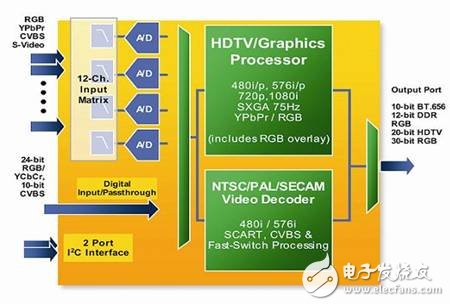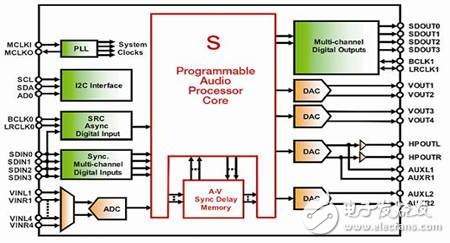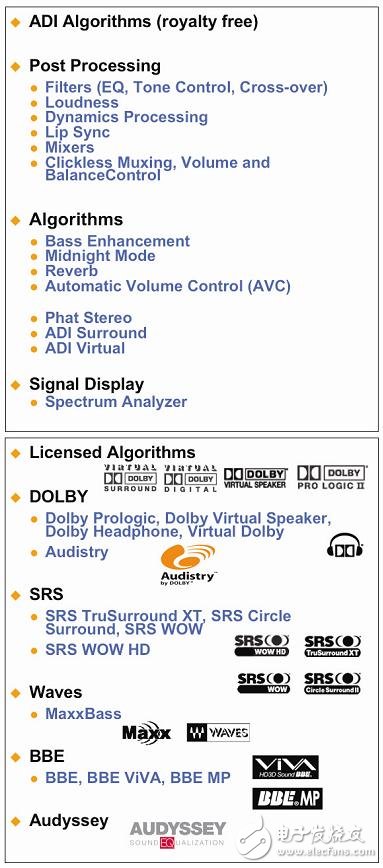As HDTV display technology matures, the quality of analog video and audio processing will eventually make a difference between TV sets. Digital processing in HDTV (including image scaling, de-interlacing, and MPEG demodulation) continues to play an important role, but these features will soon become standardized. The analog processing of video and audio signals in HDTV directly affects the user's "TV viewing experience," but HDTV manufacturers are rapidly seeking improvements in their TV analog circuit designs to increase sales and profits. This article will discuss some of the issues and design considerations for high-performance analog signal processing in HDTV.
In liquid crystal (LCD) televisions and plasma (PDP) televisions, flat panel displays themselves have historically been different in terms of the main performance of HDTV televisions. The development costs of the seventh and eighth generation LCD flat panel displays have reached billions of dollars, but recent enhancements in PDP displays have forced some companies to form joint ventures to share their financial resources and technology. Currently, almost all leading manufacturers of LCD TVs and PDP TVs are joint ventures with other TV manufacturers that primarily produce display designs. This has caused "fair competition" regarding the performance of LCD and PDP displays. The display screens produced by these joint ventures are currently used in several competitive HDTV models from different TV manufacturers.
An analog interface is required to support older devicesEven in the emerging phase of high-definition digital broadcasting, HDTV still requires analog interfaces and digital interfaces. We need composite, component, and RGB signal analog interfaces to support older standard definition (SD) devices such as video recorders (VCRs), camcorders, DVD players, and personal computers (PCs). Since users expect their SD TV programs to have the same quality as high definition (HD) TV programs, high performance analog interfaces must be designed. The integrated multi-format video decoder (such as Analog Devices' ADV7403) includes a high-performance video decoder for composite video signals and a three-channel analog-to-digital converter (ADC) for digital component analog video and RGB.
When designing an analog interface, it is important to provide a clean, low noise power supply with a short printed circuit board (PCB) connection from the connector to the device input. We also recommend a PCB design with a complete ground plane to minimize total PCB noise and reflection. Shortening the length of the digital output (including data and clock) traces helps reduce the possibility of high-frequency signal reflections that can disrupt signal integrity.
Since the analog YUV signal recorded in a DVD movie has a 10-bit resolution (which can represent more than one billion different colors), it is important to choose an analog interface that accurately reproduces colors using a 10-bit (or higher) resolution ADC. For example, Analog Devices' ADV7403 multi-format video decoder integrates a 12-bit, 140-MHz ADC to maximize image quality.

ADV740312bit Multi-Format Video Decoder Block Diagram
Audio presents more challenges to HDTVAudio processing in HDTV has several interesting design challenges. A television casing that tends to be narrow will inevitably reduce the size of the speaker while reducing the space required for heat dissipation of the amplifier. Since HDTVs are commonly used as home theaters, the audio circuitry in the TV must support the latest surround sound and bass enhancement algorithms. HDTV must accomplish significant improvements in these SD audio while achieving the ambitious goals of low cost and early launch. Cathode Ray Tube (CRT) Display SD TVs can only reproduce stereo (2.0 audio) and have a large TV case that is easy to place speakers of the appropriate size. HDTVs with LCD or plasma displays have a narrow TV case that can only be used with smaller speakers, thus limiting acoustic performance. HDTV TV shows use surround sound (5.1 audio) playback, so audio design engineers must design high-quality audio products to enable HDTV to work under these constraints while still meeting stringent cost requirements. Design engineers now use programmable audio processors to develop a single-speaker audio platform that can be integrated into different HDTV models that can use speakers of all sizes. Design engineers have used the latest psychoacoustic research to develop new audio processor algorithms that use two or three speakers in HDTV to provide sound to the listener from a complete multi-speaker surround sound system experience.

ADAV400 Programmable Audio Processor Block Diagram
To properly support popular third-party virtual surround and surround sound algorithms, the audio processor must include an audio codec and a digital-to-analog converter (DAC) with excellent analog performance. For example, Analog Devices' ADAV400 (for compensating for narrow speakers) with active equalization technology supports popular third-party algorithms and the analog performance required to produce full, thick sound. Graphical software tools such as SigmaStudio allow complete control of the entire sound environment.

Extended audio algorithm library
Finally, Class D audio amplifiers minimize the size of the heat sink and other external components, making them suitable for the tight spaces of new HDTV products. The use of large kinescopes in CRT TVs leaves a large chassis space for audio design engineers, allowing CRT TV audio design engineers to use Class AB amplifiers, which are inefficient and often require large heat sinks. Design engineers can use their high-efficiency Class-D audio amplifiers, such as the Analog Devices AD1991 (>85% efficiency at full power), to adapt their audio amplifier circuits to their small footprint without compromising audio quality or power output.
HDMI is the interface to watch the latest high-definition DVDIf you are tired of the original back of your phone, you should try our 3D Relief Back Sticker. The Back Skin Protective Film on the back can not only bring you a visual change, but also protect the back cover of the phone itself from scratches and collisions. Real 3D touch, personalized and stylish pattern design. Bring you a perfect experience.
In daily use, it can protect the equipment from scratches, dust, impact and other damage.
Long-lasting anti-scratch effect, significantly reducing dust, oil stains and fingerprint stains.
Easy to install, easy to stick to the back of the phone, and will not damage the original appearance of the phone.
With the Protective Film Cutting Machine, you can install the Back Film on different types of mobile phone back shells, including mobile phones, tablet computers and other electronic products. Customization can be completed in 30 seconds with just one click.
If you want to know more about 3D Relief Back Sticker, please click product details to view the parameters, models, pictures, prices and other information about 3D Relief Back Sticker.
Whether you are a group or an individual, we will try our best to provide you with accurate and comprehensive information about 3D Relief Back Sticker!
3D Phone Sticker, Carbon Fiber Back Sticker, 3D Relief Back Sticker, 3D Printing Back Sticker, Phone Skin,Mobile Phone Back Sticker
Shenzhen Jianjiantong Technology Co., Ltd. , https://www.tpuprotector.com